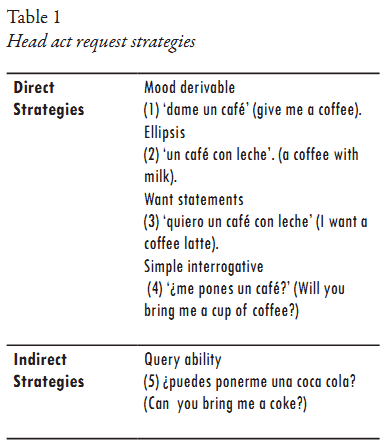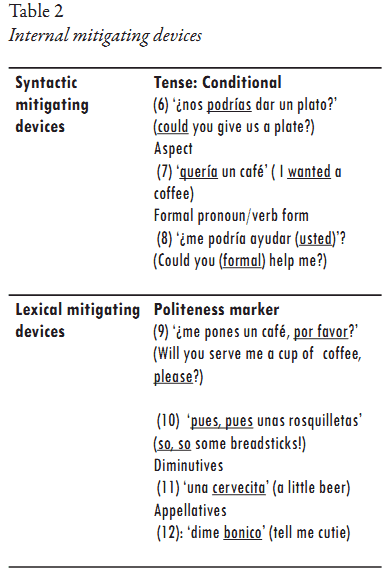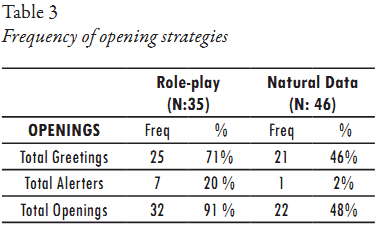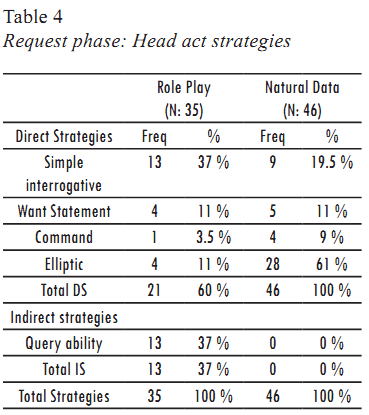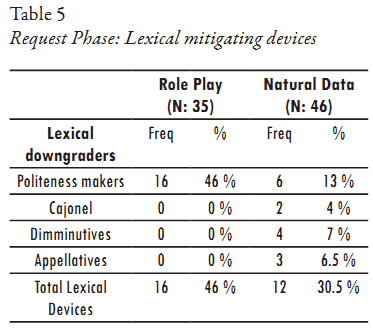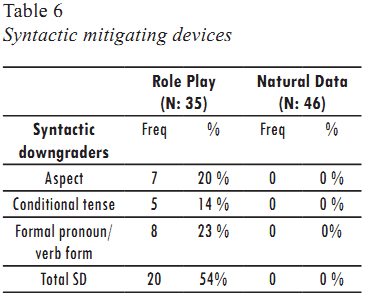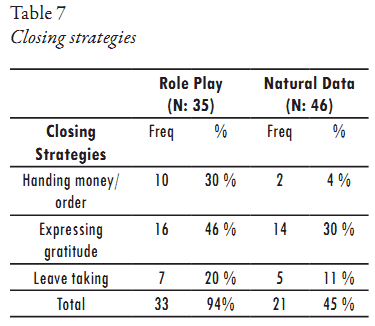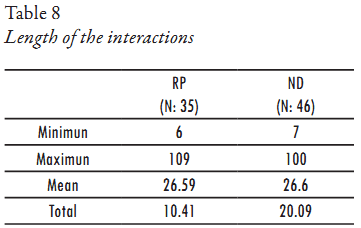Services on Demand
Journal
Article
Indicators
-
 Cited by SciELO
Cited by SciELO -
 Access statistics
Access statistics
Related links
-
 Cited by Google
Cited by Google -
 Similars in
SciELO
Similars in
SciELO -
 Similars in Google
Similars in Google
Share
Íkala, Revista de Lenguaje y Cultura
Print version ISSN 0123-3432
Íkala vol.18 no.2 Medellín May/Aug. 2013
METHODOLOGICAL ARTICLES
ROLE-PLAYS VS. NATURAL DATA: ASKING FOR A DRINK AT A CAFETERIA IN PENINSULAR SPANISH
JUEGOS DE ROL VS. DATOS NATURALES: CÓMO PEDIR ALGO DE BEBER EN UNA CAFETERÍA EN ESPAÑOL PENINSULAR
Rebeca Bataller*
* Department of Spanish, Gettysburg College, Gettysburg. Mailing address: 300 North Washington St. Gettysburg, PA 17325-1400. E-mail: rbataller@gettysburg.edu
Received: 2013-04-23/ Reviewed: 2013-04-24 / Accepted: 2013-05-27 / Published: 2013-08-01
How to reference this article: Bataller, R. (2013). Role-plays vs. natural data: asking for a drink at a cafeteria in peninsular Spanish. Íkala, revista de lenguaje y cultura, 18(2), 111–126.
ABSTRACT
The purpose of this study is to compare the data collected, via two methods, from two groups of Peninsular Spanish native speakers in a service encounter scenario. The methods chosen are open role-plays and naturally occurring interactions, two frequently used approaches in the field of pragmatics. The naturalistic data from this study consisted of request-for-service transactions at cafeterias in Valencia, Spain; these were recorded with audio equipment and then analyzed at the illocutionary and discourse levels. The features analyzed were the strategies and mitigating devices used in all phases of the interactions. The structure and length of interactions from each dataset were also compared. The results of this comparative study indicate that the role-play data resembled the naturalistic interactions in some respects, but there were also some significant differences between the two datasets that may be attributed to the particular type of collection method.
Keywords: data collection methods, role-play, naturalistic interactions, requests
RESUMEN
El objetivo de este estudio es comparar aspectos pragmáticos de datos obtenidos por dos métodos de recolección de datos diferentes: los juegos de rol y las grabaciones de conversaciones reales. Los datos provienen de dos grupos de participantes nativo hablantes de español peninsular en un contexto de prestación de un servicio. Las conversaciones auténticas fueron recogidas en dos cafeterías situadas en el campus de la Universidad de Valencia, España. Las interacciones entre los clientes y los camareros fueron captadas con una grabadora digital y analizadas a nivel ilocutorio y discursivo. Los elementos analizados fueron las estrategias principales y los elementos de mitigación usados en distintas fases de las interacciones. La estructura y longitud de las interacciones en cada muestra fueron también analizadas y comparadas. Los resultados de este estudio comparativo indican que los datos obtenidos a partir del juego de rol son similares a las conversaciones ''reales'' en varios aspectos, sin embargo también hay diferencias significativas entre las dos muestras que pueden ser atribuidas al tipo de instrumento de recolección de datos utilizado.
Palabras clave: métodos de recolección de datos, juegos de rol, grabaciones de conversaciones reales, peticiones
1. INTRODUCTION
The comparison of data collection methods in pragmatics research is a topic that has received considerable attention in the last few decades (e.g. Bataller and Shively, 2011; Beebe & Cummings, 1996; Félix-Brasdefer, 2003, 2007; Hartford &Bardovi-Harlig, 1992; Kasper, 2000; Golato, 2003; Kasper & Dahl, 1991; Kasper & Rose, 2002; Rintell & Mitchell, 1989; Tran, 2006). There are several methods that can be used to collect pragmatics data; however, role-plays, written questionnaires and naturalistic data collected via audio recordings and field notes are probably the most frequently used and discussed in the literature. Some studies have pointed out the advantages and disadvantages of each of these methods, comparing them in terms of their validity, comparability and practicality (Félix- Brasdefer, 2003; Tran, 2006). Overall, this research has found that role-plays and written questionnaires are both valid methods of data collection and that they are practical for collecting large amounts of data and give good control of contextual variables. However, researchers agree that naturally occurring data is more valid as it represents what speakers actually say in real-life interactions (e.g. Bataller & Shively, 2011; Félix-Brasdefer, 2003).
Though several studies have compared role-plays and questionnaires, there are far fewer that compare role-plays with natural data. Furthermore, while requests have been the focus of some method studies (e.g. Félix-Brasdefer, 2007; Kasanga, 1999), to our knowledge, only Bataller and Shively (2011) studied service encounter requests comparing two methods of data collection.
Hence, the purpose of this study is to compare the realization of transactional requests collected via an open role-play and audio recordings of authentic data, in addition to describing service encounter interactions in cafeterias by university students from Valencia, Spain. There are very few studies analyzing service encounter requests in this context in Peninsular Spanish (Placencia and Mancera Rueda, 2011a, 2011b) and none of them focused on this region of Spain (Valencia).
2. LITERATURE REVIEW
A variety of data collection methods has been employed in pragmatics research. These include written questionnaires, elicited and spontaneous conversations, closed and open role-plays, diaries, audio recordings and field notes (e.g. Cohen, 2004; Kasper and Dahl, 1991; Kasper, 2000). In the following section we discuss what research has discovered about three specific methods: the written questionnaire or discourse completion task (DCT), the role-play (RP) and naturally occurring data. We then provide an overview of previous research on service encounters in Peninsular Spanish.
2.1. Elicited methods of data collection
2.1.1. The written questionnaire (DCT).
For decades the most frequently used method of data collection in pragmatics was the DCT. In this approach participants are given different scenarios and they are asked to write in a given space what they think they would say if they found themselves in those scenarios in real life. This method has been widely used in interlanguage pragmatics (Barron, 2000, 2003; Hoffman-Hicks, 1999; Kondo, 1997; Matsumura, 2001; Rodriguez, 2001), and cross- cultural pragmatics studies (Ballesteros-Marin, 2002; Mir, 1993; Pinto, 2002), due to its ability to collect large amounts of data in a short period of time. However, the disadvantages of the DCTs in comparison to other methods have also been widely discussed. First, DCTs have been criticized for representing what participants believe they should say, and not necessarily what is actually said in real life situations. Additionally, participants have time to think about their responses, which are then less spontaneous than those made orally (Barron, 2003).
2.1.2. The Role-play (RP).
In the last few decades, more and more researchers analyzing speech acts have used RPs as a method of data collection (Bataller, 2010; Félix-Brasdefer, 2002, 2007; García, 1989, 1993, 1999; Márquez-Reiter, 2000; Rintell, 1981; VonCanon, 2005). As Tran (2006) explains, ''role-plays can be defined as simulations of social interactions in which participants assume and enact described roles within specified situations'' (p. 3). There are two types of RPs: closed and open. Closed RPs involve one turn each by the participant and the interlocutor, whereas open RPs allow participants to take as many turns as they need in order to complete the required task (Kasper & Dahl, 1991).
Several studies have noted that RPs are a more valid measure of authentic language use compared to DCTs (Eisenstein & Bodman, 1993; Félix- Brasdefer, 2003; Tran, 2006). As Kasper (2000) points out, in comparison to questionnaire data, RP data capture many of the discourse features found in natural speech: intonation, pauses, turn-taking, overlap and laughter, among others. Role-play interactions also elicit more negotiation, repetition and supportive moves in comparison to written methods (Beebe & Cummings, 1996; Félix-Brasdefer, 2003; Margalef-Boada, 1993).
Overall, research has shown that elicited methods of data collection have advantages over natural data regarding practicality, as they allow the collection of large amounts of comparable data (Kasper, 2000). Furthermore, there are certain speech acts that would be very difficult to collect via natural data because they occur infrequently in spontaneous interactions or they are difficult for researchers to collect (Billmyer & Varghese, 2000; Cohen, 1996; Kasper & Dahl, 1991).
2.1.3. Natural data (ND).
Naturally occurring speech clearly represents the most valid measure of actual language use as it shows ND with discourse features (Tran, 2004). However, as previously stated, it does not allow the researcher to exercise control over social and contextual variables. This lack of control makes it difficult to replicate the same scenario and to compare speech samples from different individuals or groups in a systematic manner (Beebe & Cummings, 1996; Tran, 2004).
2.1.4. Comparison method studies.
There are many studies that have compared DCT and RP data (Beebe & Cummings, 1996; Franch and Lorenzo-Dus, 2008; Golato, 2003; Hartford & Bardovi-Harlig, 1992; Rintell & Mitchell, 1989; Rose, 1994; Yuan, 2001). Some of these studies have noted that in the RP data nonnative speakers' responses were longer because they included more and longer supportive moves, as well as hesitations (Margalef-Boada, 1993; Rintell & Mitchell, 1989). Rintell and Mitchell (1989, p. 266) suggested that in RPs, their nonnative speaker participants may have wished to be clearer and more polite to their interlocutors and therefore they provided more supporting moves, while this need did not apply in DCT data.
Studies comparing DCTs and ND have found that the ND was more direct and less elaborate than that gathered from DCTs. Kasanga (1999) compared natural requests with those elicited from DCTs of a group of English learners from South Africa. She found that in the ND learners were more direct and used fewer supporting devices than in the DCTs. As Kasanga stated, this could be the result of two factors: on the one hand, in the DCT learners had more time to think about their responses, and may have used more devices to make their requests more polite. In addition, the test-like format of the DCT may have influenced learners' responses, making them want to appear more formal. Omar (1992) also found that in natural conversations learners were more straightforward in their use of greetings, cutting short the conversation openings, while on the DCT they used more greeting strategies as they may have wanted to demonstrate their knowledge of these speech acts and forms.
Over the last two decades, some studies have compared RPs with ND in different contexts (Bataller & Shively, 2011; Eisenstein & Bodman, 1993; Félix-Brasdefer, 2007; Hasall, 1997; Tran, 2004, 2006; Turnbull, 2001). Hassall (1997) noted that L2 learners in RP situations used information from the description of the situations and as a result produced longer and more elaborate responses than they would in real-life contexts. Turnbull (2001) argued that RP participants tended to make more verbose requests, repeating themselves and asking for additional information than participants in the ND. Félix-Brasdefer (2007) found that the requests in the natural settings showed greater variability in prosodic features, had longer requesting sequences, and more idiomatic expressions than requests in the RPs. Furthermore, the naturally-occurring requests also displayed features that the RP data did not show, such as the use of elliptic request strategies and negation as a mitigator. In spite of the differences, the similarities between the two methods made the author state that ''the results of the present study show that role-plays represent an approximation to spoken discourse'' (Félix- Brasdefer, 2007, p. 177).
Bataller and Shively (2011) analyzed the L2 learners' development of service encounter requests after studying abroad for a semester in Spain using RPs and naturalistic data. They found that the RP data were similar to the naturalistic data in terms of structure, sequence and turn taking. In addition, they shared similarities in the learners' development of request strategies. However, they also found important differences, such as greater variability and longer interactions in the ND and some features and strategies that only appeared in the natural interactions; for example, use of small talk, server repetition and well-wishing. In contrast, the RP participants used want statements extensively and lacked lexical specificity in some requests for beverages (e.g., quiero algo de beber 'I want something to drink'); they used alerters (e.g., perdóname 'excuse me'), and showed a more frequent use of lexical and syntactic mitigation. As the authors explained, the description of the RP scenario that the students were given to read probably accounted for their use of the verb querer ('to want') and the lack of lexical specificity when requesting. Even though both methods shared many similarities, RPs may have ''the methodological disadvantage of being susceptible to influence from the description of the scenario and the fact that simulated interaction may produce some seemingly inauthentic uses of language'' (Bataller & Shively, 2011,p. 48).
The present study aims to compare interactions collected via open RPs with audio recordings of authentic interactions of two groups of Peninsular Spanish native speakers (NSs) making transactional requests at cafeterias in Valencia, Spain. To our knowledge, to date, only Bataller and Shively (2011) have compared service encounter requests using these two methods of data collection. However, the participants and pragmatic focus between the two studies differs completely. Bataller and Shively analyzed L2 learners' pragmatic development, whereas the present study aims to describe the interactions of Peninsular Spanish NSs in this particular context.
2.1.5. Service encounter requests in Peninsular Spanish.
Service encounter interactions have been the focus of several studies in a variety of languages during the last two decades (Aston, 1995; Callahan, 2009; Félix-Brasdefer, 2012; García, 1993; Hickey, 2005; Kerbrat-Orecchioni, 2005; Kidwell, 2000; Márquez Reiter, 2005, 2006; Placencia 1998, 2004, 2005; Placencia & Mancera Rueda, 2011a, 2011b; Traverso, 2001; Vélez, 1987). It is important to note that, as Danblon et al. (2005) explained, service encounters requests are different from other types of requests because it is the hearer (i.e. the service provider) and not the speaker (i.e. the customer) who normally benefits from the exchange, and, as a result, service employees use more politeness markers than customers in order to show friendliness, good manners and respect.
Within the last few years, research into service encounters in the Hispanic world has rapidly evolved. Studies have shown that even though there are similarities, cultural differences between different regions can be apparent (Félix-Brasdefer, 2007; Marquez-Reiter & Placencia, 2004; Placencia, 2005, 2008; Placencia & Mancera Rueda, 2011a, 2011b). There are only a few studies that have described service encounter performance in Spain (Placencia, 2005; Placencia & Marcera Rueda, 2011, 2011b). In a study of naturally occurring corner-shop encounters in Madrid and Quito, Placencia (2005) noted that in Madrid the interactions frequently started with a brief opening immediately followed by the request. The requests were mostly done with few internal mitigators, and using mainly direct strategies.
In another study, Placencia and Mancera Rueda (2011a) analyzed naturally occurring requests in two cafeterias in Seville that differed mainly in the degree of familiarity between the establishment providers and their clients. Even though they found relevant differences between the two contexts, overall, participants seemed to use mostly direct request strategies and hardly any internal mitigation in their requests for a service. The present study also analyzes transactional requests in cafeterias. However, it has a different approach as it compares data obtained via two methods of data collection, and it focuses on a different region of Spain: Valencia.
3. RESEARCH DESIGN
3.1. Participants
There were two groups of participants in the present study. The RP group was formed by 36 NSs of Peninsular Spanish, 14 males and 22 females. They were all students from the University of Valencia and their ages ranged from 18 to 24. Their native language was Spanish; however, four were Spanish-Valenciano bilingual speakers.
The ND group consisted of 46 Peninsular Spanish NSs with similar characteristics as the RP group.
Even though we could not collect their exact age, we assumed they were all university students, because the recordings were made at two different cafeterias within the university campus where clients are mostly students. Furthermore, in order to ensure both datasets were similar, we excluded those interactions with older customers who could well have been professors or staff members from the university. We also excluded those participants who showed any degree of familiarity with the bartender in order to keep a similar scenario to the one described in the open RP.1
3.2. Data collection methods
Two main methods of data collection were used in the present study: an open RP and naturalistic data composed of audio recordings made with a digital recorder.
3.2.1. The open role-play.
In the open RP participants interacted with a Peninsular Spanish NSs in six different scenarios, only one of which is analyzed for the purpose of this study. Before beginning the RP, participants received a card with the following description of the scenario in Spanish:
Estás en una cafetería cerca de la universidad porque quieres beber algo (agua, una Coca-cola, un zumo, un café...). Vas a la barra y le pides algo para beber a la camarera, a la cual no conoces de nada.
(You are in a cafeteria close to the campus because you want to get a drink (water, a Coke, some juice, coffee...). You go up to the counter and order something to drink from the person behind the counter. You do not know her.)
A 31-year-old Spanish female performed the role of the bartender. The RPs took place in an empty room at the University of Valencia, where one participant at a time entered the room and performed the RP, which was audio recorded.
3.2.2. Naturalistic data.
Natural data was collected via audio-recordings that the researcher made at two cafeterias from the university campus with a digital recorder. The corpus used for the present study included a total of 46 interactions between university students and four bartenders (two men and two women).
The researcher obtained Institutional Review Board (IRB) approval to make the audio recordings and requested permission from the establishments to tape them. The recorder was placed on the counter and the researcher sat at a nearby table in order to observe and take notes of the clients' characteristics (e.g. age range and gender).
3.3 Data analysis
After the data were transcribed, the interactions were subdivided into three phases: the opening, the request and the closing section. The main strategies and internal mitigating devices were analyzed and compared between the two datasets. In addition, the structure and length2 of the interactions were contrasted.
There were two opening strategies: greetings and alerters, and three closing strategies: leave taking, expressing gratitude and handing over money. Request strategies and internal mitigating devices were coded using a modified version of the categories developed by Blum-Kulka et al. (1989), shown in Tables 1 and 2 below. An example of the strategies used is provided.
After the strategies and the supporting devices had been classified, the frequency of the strategies used was calculated and compared between both groups. In addition to the frequencies, a qualitative description of different elements in the interactions was included to complement the quantitative analysis of the data.
4. RESULTS
4.1. Results: the opening phase
In order to establish contact with their interlocutors, participants used either greetings (e.g. hola [hello]), alerters (e.g. mira [look]) or no opening strategy at all.
As table 3 shows, the RP interactions used opening strategies more frequently than those from the ND (RP: 91%, ND: 48%). This result shows that several real life interactions started often directly with the request and did not include an opening phase. This may have been a result of the conditions in which the interactions were recorded. In these particular cafeterias the exchanges between bartender and customers were often quick, because, at times, several people were waiting to be served, and the main objective for the bartender seemed to be to get the customer's order in the most efficient manner, as example (13) illustrates: 3
(13) BT: ¡a ver, chavales! (come on, guys!)
C: un bocadillo de anchoas (an anchovies sandwich)
Regarding the type of opening strategy, both groups preferred to use greetings (RP: 71%; ND: 46%). Furthermore, both groups used the same three strategies (hola [hello], buenas [good morning], and hola, buenas! [hello, good morning!]). However, the frequency of use of each of these differed. The RP participants used the compound formula hola, buenos días (hello, good morning) more frequently (12 total or 34%), while in the naturalistic data, the strategy hola (hello) (16 or 35%) was used more often.
Alerters were more common in the RP (7 or 22%) than in the ND (1 or 2%). Only in the RP data were there cases where both greetings and alerters appeared in the same opening phase, as example (14) shows:
(14) C: ¡Hola! perdona! (Hello! excuse me!)
In sum, there were some differences and a few similarities between the openings of the interactions. Role-play interactions almost always included opening strategies, and these were longer than those found in the ND. At times, they included both alerters and greetings, and compound formulas were more frequent than simple ones. In contrast, 30% of the naturalistic interactions did not include an opening phase, and the most frequent greeting was the simple formula hola (hello).
4.2. Results: The request phase
The request phase appeared either right after the opening sequence, or as the first move of the interaction. Table 4 shows the type of head act strategies4 that each group of participants used in the request phase.
As Table 4 shows, both groups of participants used far more direct strategies than indirect ones: RP 21 or 60%, and ND 46 or 100%. Moreover, they both used the same type of direct strategies (simple interrogatives, want statements, elliptics and commands). However, they differed in the frequency of use of each specific strategy. While in the ND 28 or 61% were elliptics (e.g. un café solo [a black coffee]), this strategy was hardly used by the RP group, (4 or 11%). Rather, they tended to use 'simple interrogatives', (12 or 34%), a strategy rarely used in the naturalistic interactions (9 or 19.5%).
(15): C: ¿me pone una Coca-cola light?
(will you serve me a diet Coke?)
The other two direct strategies found in the data, want statements and commands, were used with much less frequency. Commands were more frequent in the ND (4 or 9%), appearing only once in the RPs.
(16) C: ponme una Coca-cola (bring me a Coke) [command]
Even though both groups used overall more direct strategies, only the RP participants used indirect ones, in 13 or 37% of the interactions. The only instance in which a participant used an indirect strategy in the ND was to ask a favor to the bartender. This example was not counted as a transactional request as there was no benefit for the bartender.
(17) C: ¿nos podrías dar un plato, por favor?
(Could you give us a plate, please?)
In sum, there were some similarities and some relevant differences in the request phases of the data collected by both methods of data collection. While both groups used more direct strategies, the most frequent one in the RP data was the simple interrogative, and the elliptic in the naturalistic interactions. Furthermore, only the RP participants used indirect strategies, and they did so quite frequently.
4.3 Results: Lexical Internal mitigating devices
Table 5 shows the type and frequency of use of lexical downgraders that the two groups of participants used in the request phase.
As we can observe from table 5, the range of lexical internal mitigators was much greater in the ND. While in the naturalistic interactions four types of lexical internal mitigators were used: politeness markers (e.g. por favor, [please]), cajolers (e.g. pues, [well],), diminutives (e.g. bocadillito [a little sandwich]), and appellatives (e.g. bonico, [cutie]), the politeness marker was the only one used by the RP participants. The politeness marker was the most frequently used device in both groups. It appeared in 46% of the RP interactions, while it was only used in 13% of the real-life interactions. Cajolers (2 or 4%), diminutives (4 or 7%) and appellatives (3 or 6.5%) were used occasionally in the ND. As García (1993) notes, diminutives and appellatives can be categorized as strategies that show solidarity and closeness towards the interlocutor, while politeness markers may be considered deference strategies.
Below are examples of the use of these lexical mitigating devices.
(18) ¿me pone una coca-cola, por favor? (Will you [formal] serve me a Coke, please?)
[politeness marker, RP]
(19) una cervecita, por favor (a little beer, please) [diminutive, ND]
(20) pues, pues unas rosquilletas (well, well some breadsticks) [cajoler, ND]
4.4. Syntactic mitigating devices
Table 6 shows the type and frequency of use of syntactic downgraders that the two groups of participants used in the request phase.
As table 6 shows, there was a clear difference in the use of syntactic mitigating devices between both datasets. While there were 20 instances of internal mitigation in the RP interactions, no syntactic mitigation was found in the ND.
Among the syntactic mitigating devices the RP group used, the formal pronoun/verb form and aspect were the most frequently used, followed by the conditional tense:
(21) Quería un zumo de naranja, por favor (I would like an orange juice, please) [aspect]
(22) ¿me podría poner una Coca-cola? (could you (formal) serve me a Coke?) [conditional tense and formal verb form]
The lack of use of syntactic mitigation in the ND does not surprise us as previous studies have also noted a minimal use of internal mitigation in service encounter requests in Spain (Placencia & Marcera Rueda, 2011a; Placencia, 2005).
To sum up, there were both differences and similarities in the request strategies used in the interactions collected from both methods of data collection. On the one hand, both datasets presented more direct strategies than indirect ones, and a more frequent use of the informal pronominal pronoun tú versus usted. On the other hand, the RP interactions showed more deferential strategies, such as quite frequent use of internal mitigating devices, presence of the formal pronoun usted, and of a considerable number of indirect requeststrategies. However, the naturalistic data presented more solidarity strategies, such as the use of only direct head acts, internal mitigators expressing solidarity (e.g. diminutives, appellatives) and the presence of the informal pronoun tú in all interactions.
4.5. Results: The closing phase
After the request phase, the interactions usually proceeded with a negotiation phase in which the specifics of the order and the payment of the order took place. This was often followed by a closing phase that included strategies such as gratitude expressions (e.g. gracias [thank you]), leave taking formulas (e.g. adiós [good bye]), or handing over money or the order (e.g. toma [here you are]).
As table 7 shows, while most RP interactions ended with a closing strategy, only 45% of the naturalistic ones did. However, the same strategies were used in both datasets. Expression of gratitude was the most frequent in both datasets (RP: 46%; ND: 30%). Furthermore, while in the RP there were more handing money/ product strategies, (30%), this strategy appeared in just 4% of the ND interactions. Leave taking strategies were used with a moderate frequency in both datasets (RP: 20%, ND: 11%).
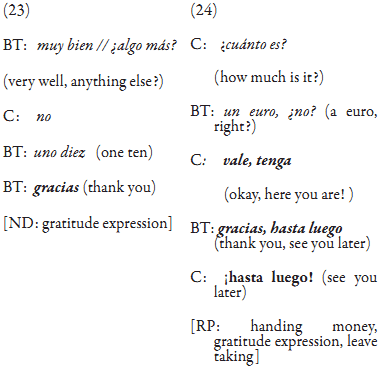
In terms of the structure of the closing phase, we noted that the RP closings were longer, often involving more than one strategy. In fact, 40% of the RP interactions used more than one closing strategy, while only 17% of the ND exchanges did. Examples (23) and (24) illustrate this difference.
Overall, we can state that there were similarities and some differences between the closing phases from the data collected with each method of data collection. While the same strategies were used in both datasets, the RP interactions contained more and longer closing phases than the naturalistic ones as the examples above shows.
4.6. Results: Length of the interactions
Table 8 shows the minimum and maximum number of words per interaction from each group, as well as the mean and standard deviation of the number of words calculated from each dataset.
We see from table 8 that the RP and naturalistic interactions were similar in length (RP: 26.59; ND: 26.26). However, looking at the standard deviations, we observe that the naturalistic data was more variable (ND: 20.09; RP: 10. 41). This greater variability indicates that some of the interactions were short and others long. This difference in length of the naturalistic interactions may come from the inclusion of non-transactional talk in some of the exchanges. In fact, there were five different episodes of non-transactional talk in the naturalistic interactions, while there was none in the RP. Example (25) includes the presence of non-transactional talk in a natural interaction between a student and a female bartender.
(25)
C: ¿me pones una napolitana de chocolate?
BT: a ver, una napolitana
C: ¿cuánto es?
BT: uno veinticinc, ¿algo més?5
C: no, no, de momento ya voy bien
BT: ya, vas bien, ay! qué buenas que están!, a mí me encantan, a mí las napolitanas de chocolate, uff, yo cuando desayuno napolitana digo, a tomar por saco!
C: exacto
BT: que me vaya al culo, me da igual
C: yo, como he acabado mi último examen, a comer bien!
(...)
C: will you give me a chocolate croissant?
BT: let's see, a chocolate croissant...
C: how much is it?
BT: one twenty five. anything else?
C: no, no, that'll do me fine.
BT: I know, that will do you fine! oh! they taste so good, I love them! to me, chocolate croissants, yum!, when I have a chocolate croissant for breakfast, I say, to hell with diets!
C: exactly!
BT: it can go to my butt, I don't care
C : I have finished my last exam, so I deserve to eat something delicious.'
(...)
As Placencia and Mancera Rueda (2011b) note, the use of non-transactional talk is common in service encounter interactions, and often has the effect of making the service a pleasant and even entertaining encounter, as the present example illustrates.
5. CONCLUSION
The present study compared service encounter interactions recorded via two methods of data collection: a role-play (RP) and audio recordings of real life interactions (ND). The specific service encounter analyzed was transactional requests in a cafeteria performed by Peninsular Spanish university students in Valencia, Spain. The main goal of this study was to observe whether the RP data was similar or not to the naturally occurring interactions in this particular context.
The results of this study suggest that there were some similarities and relevant differences in the service encounter interactions recorded via the two methods of data collection. In terms of the structure and length of the interactions, both methods brought similar results. Most conversations included an opening, followed by the request phase, negotiation about the order and a closing phase. The main difference in terms of the structure was the fact that most of the RP exchanges contained an opening phase (91%) and a closing phase (94%), while this was not the case in the natural exchanges, with only 48% of the interactions including an opening and 45% having a closing phase. The less frequent use of opening and closing phases in a considerable number of ND exchanges may be explained by the effect of local conditions of real life interactions in this type of establishment (e.g. noise or time constraints). As the researcher observed, the cafeterias where the natural interactions were collected were sometimes crowded and the communication exchanges between providers and clients were often made in the quickest way possible.
Furthermore, even though the mean number of words in both datasets was similar, the naturalistic interactions were more variable in length than the RPs. The use of small talk in some of the natural interactions probably accounted for the longer interactions in that dataset. Bataller and Shively (2011) also found considerable variability in the length of the ND, as well as more inconsistency regarding the presence or absence of openings and closings than in the RPs.
Regarding the strategies used in all phases of the interactions, we also found some similarities and clear differences between the data collected by each method. First of all, in the opening section, the interactions from both datasets started mainly with greetings (e.g. hola [hello]) rather than alerters (e.g. perdona [excuse me]). However, the openings in the RPs often included some alerters, and longer compound formulas (e.g. hola, buenas! [hello, good morning!]) that were seldom found in the ND. Placencia (2005) also noted that the openings in the corner shop interactions in Madrid were often short and did not include alerters, as the results from the ND in this study show.
Another similarity between the datasets was that both groups used more direct than indirect strategies, as previous studies analyzing service encounters in Peninsular Spanish have also found (Placencia & Mancera Rueda, 2011a; Placencia, 2005). However, there were differences in the specific strategies used by each group. While elliptics (e.g. un café [a coffee]) were more frequent in the ND, simple interrogatives (e.g. '¿me pone un café? [Will you bring me a coffee?]) were preferred in the RP. Comparing these two strategies, elliptics could be regarded as more direct strategies, as they do not make use of any linguistic feature to mitigate the imposition of the request. On the other hand, the simple interrogative may be considered a more deferential and indirect strategy, because it has a question-like structure that softens the imposition of the request. A further difference between the sets was the use of indirect strategies in the RP while not occurring at all in the natural dataset. As Placencia and Mancera Rueda (2011a) noted, indirect requests are not commonly used in these contexts in Peninsular Spanish. Hence, we believe that the RP participants might have used them as a result of the method they were using. As other researchers have noted (Aston, 1995; Barron, 2003; Golato, 2003), in elicited methods of data collection, participants may act as they think they should in simulated situations, which may be different from what they would actually do in a real-life scenario. The use of internal mitigation was also different in each dataset. Although no use of syntactic mitigation was noted in the ND, there were 20 instances of syntactic internal mitigation on the RP interactions. The use of the formal pronoun usted in 32% of the RP interactions contributed to making their exchanges more formal and deferential. Usted was never used in the naturalistic data. Hence, the presence of usted and other syntactic mitigating devices in the RP data seems to demonstrate that RP participants may have wished to sound more polite using these deferential strategies than the ND participants.
Placencia (2005) and Placencia and Mancera Rueda (2011a) reported the use of the informal pronoun tú in most cases in the natural data collected from their Peninsular Spanish participants. Therefore, the results from the naturalistic data in this study concur with those of previous research analyzing Peninsular Spanish service encounter interactions. There is actually an increasing use of tú versus usted, particularly in the young generation in Spain (Recuero, 2007; Blasco-Arroyo, 1994).
Also, the only lexical mitigator used in the RP, the politeness marker -e.g. por favor (please) can be considered a deferential strategy used to soften the imposition of the request. Instead, some of the lexical downgraders used in the ND (e.g. diminutives) can be regarded as solidarity strategies that are used to display familiarity and in- group membership. In keeping with the ND from the present study, Placencia (2005) and Placencia and Mancera Rueda (2011a) noted only a slight use of internal mitigation in the service encounter interactions from their Peninsular Spanish data.
Overall, we can conclude that the ND from this study was more direct than data from the RP, which in comparison included more indirect strategies. Furthermore, the naturally occurring interactions contained more solidarity strategies (e.g. use of tú only, use of diminutives and appellatives, use of only direct strategies, use of small talk), while the RP participants used more deference (e.g. indirect request strategies, politeness markers and syntactic mitigation). Additionally, the ND was more variable both in length and in structure of the interactions. This may result from the conditions in the real-life contexts where these interactions took place (e.g. background noise, more than one person ordering at once). Previous studies analyzing similar service encounter interactions in Peninsular Spanish produced comparable results to our ND interactions (Placencia, 2005; Placencia & Mancera Rueda, 2011a). Hence, even though the RP data approximated the naturalistic interactions, it also presented some clear differences that may have resulted from method effect. As previously stated, participants may have acted as they thought they should, but not as they actually would in real- life situations.
Thus, even though we agree with Felix-Brasdefer (2007) when he states that role-plays represent an approximation to spoken discourse, we would also suggest caution when interpreting results from studies using elicited methods of data collection, as some of the findings may be conditioned by method effect. Furthermore, researchers using RPs should pay close attention to the elaboration of the scenarios and make their descriptions as clear as possible in order to help participants imagine the context that they have to represent in their interactions.
This study has certain limitations that may have influenced its results. As Placencia and Mancera- Rueda (2011a) explain, the collection of ND also has some shortcomings, which involve the difficulty of collecting personal information from the participants. Hence, even though the participants from both datasets shared similar characteristics- they were young students at university cafeterias- we could not verify the actual age of the ND participants. Furthermore, even though we tried to replicate the exact same context as in the RP, it was not possible for us to control the gender of the bartenders in the ND. In order to have a similar number of interactions in both datasets, we had to use all the interactions from the ND, which included both female and male bartenders, while in the RP only a female played the role of the bartender. In spite of these differences, we believe that both groups shared enough characteristics to make a valid comparison of the datasets. We propose future studies using different age groups to supply a broader perspective of service encounter interactions. It would also be useful to collect data from participants in different scenarios (e.g. type of cafeteria, client, degree of familiarity) as any of these factors may affect the result obtained.
AUTHOR'S NOTES
1 For a whole description of the role-play scenario, go to section (3.2.1)
2 Number of words per interaction
3 BT: bartender; C: client.
4 The head act strategy of a request refers to the actual strategy used to make the request
5 Valencia is a bilingual region of Spain where Catalan and Spanish are both spoken. The bartender uses Catalan in this turn although the conversation started and continued in Spanish.
REFERENCES
1. Aston, G. (1995). Say 'thank you': Some pragmatic constraints in conversational closings. Applied Linguistics, 16(1), 57-85. [ Links ]
2. Barron, A. (2003). Acquisition in interlanguage pragmatics: Learning how to do things with words in a study abroad context. Amsterdam, Netherlands: John Benjamins. [ Links ]
3. Barron, A. (2000). Acquiring different strokes: A longitudinal study of the development of L2 pragmatic context. German as a Foreign Language Journal, 2. 1-29. [ Links ]
4. Bataller, R. (2010). Making a request for a service in Spanish: Pragmatic development in the study abroad setting. Foreign Language Annals, 43(1), 160-175. [ Links ]
5. Bataller, R. and Shively, R. (2011). Role-plays and naturalistic data in pragmatics research: Service encounters during study abroad. Journal of Linguistics and Language Learning, 2(1), 15-50. [ Links ]
6. Beebe, L. M. and Cummings M. C. (1996). Natural speech act data versus written questionnaire data: How data collection method affects speech act performance. In S. M. Gass and J. Neu (Eds.), Speech acts across cultures: Challenges to communication in a second language, (pp. 65- 86). New York, NJ: Mouton de Gruyter. [ Links ]
7. Billmyer, K. and Varghese, M. (2000). Investigating instrument-based pragmatic variability: Effects of enhancing discourse completion tests. Applied Linguistics, 21(4), 517-552. [ Links ]
8. Blasco-Arroyo, J. L. (1994-95). Tú y usted: Dos pronombres de cortesía en el español actual: Datos de una comunidad peninsular. Estudios de Lingüística de la Universidad de Alicante, 10, 21-44. [ Links ]
9. Blum-Kulka, S, House J. and Kasper, G. (Eds.). (1989). Cross-cultural pragmatics: Requests and apologies. Norwood, NJ: Ablex. [ Links ]
10. Callahan, L. (2009). Spanish and English in US service encounters. Basingstoke, England: Palgrave Macmillan. [ Links ]
11. Cohen, A. D. (1996). Speech acts. In S. L. Mckay and N. H. Hornberger (Eds.), Sociolinguistics and Language Teaching (pp. 383-420). Cambridge, England: Cambridge University Press. [ Links ]
12. Cohen, A. D. (2004). Assessing speech acts in a second language. In D. Boxer and A.D. Cohen (Eds.), Studying Speaking to Inform Second Language Learning (pp. 302-327). Clevedon, England: Multilingual Matters. [ Links ]
13. Danblon, E., de Clerck, B. and van Noppen, J-P. (2005). Politeness in Belgium: Face, distance and sincerity in service-exchange rituals. In L. Hickey and M. Stewart (Eds.), Politeness in Europe (pp. 45-57). Clevedon, England: Multilingual Matters. [ Links ]
14. Eisenstein, M. and Bodman, J. W. (1993). Expressing gratitude in American English. In G.Kasper and S. Blum-Kulka (Eds.), Interlanguage Pragmatics (pp. 64-81). New York, NJ: Oxford University Press. [ Links ]
15. Félix-Brasdefer, J. C. (2003). Validity in data collection methods in pragmatics research. In P. Kempchinsky and C. E. Piñeros (Eds.), Theory, Practice, and Acquisition. Papers from the 6th Hispanic Linguistics Symposium and the 5th Conference on the Acquisition of Spanish and Portuguese (pp. 239-257). [ Links ]
16. Somerville, MA: Cascadilla Press. Félix-Brasdefer, J. C. (2007). Natural speech vs. elicited data: A comparison of natural and role play requests in Mexican Spanish. Spanish in Context, 4(2), 159-185. [ Links ]
17. Félix-Brasdefer, J. C. (2012). Pragmatic variation by gender in market service encounters in Mexico. In J.C. Félix-Brasdefer, J. C and D. Koike (Eds.), Pragmatic Variation in First and Second Languages (pp. 17-49). Amsterdam/Philadelphia, Netherlands: John Benjamins. [ Links ]
18. Franch Bou, P. and Lorenzo-Dus, N. (2008). Natural versus elicited data in cross-cultural speech act realisation: The case of requests in Peninsular Spanish and British English. Spanish in Context, 5(2), 246-277. [ Links ]
19. García, C. (1989). Disagreeing and requesting by Americans and Venezuelans. Linguistics and Education, 1, 299-322. [ Links ]
20. García, C. (1993). Making a request for a service and responding: A case of Peruvian style. Journal of Pragmatics, 19, 127-152. [ Links ]
21. García, C. (1999). The three stages of Venezuelan invitations and responses. Multilingua, 18, 391- 433. [ Links ]
22. Golato, A. (2003). Studying compliment responses: A comparison of DCTs and recordings of naturally occurring talk. Applied Linguistics, 24, 90-121. [ Links ]
23. Hartford, B. S. and Bardovi-Harlig, K. (1992). Experimental and observational data in the study of interlanguage pragmatics. In L. F. Bouton and Y. Kachru (Eds.), Pragmatics and Language Learning: Vol 3 (pp. 33-52). Urbana, Il: University of Illinois at Urbana-Champaign. [ Links ]
24. Hassall, T. (1997). Requests by Australian learners of Indonesian (Unpublished doctoral dissertation), Australia National University, Canberra, Australia. [ Links ]
25. Hickey, L. (2005). Politeness in Spain: Thanks but no 'Thanks'. In L. Hickey and M. Stewart (Eds.), Politeness in Europe (pp. 317-330). Clevedon, England: Multilingual Matters. [ Links ]
26. Hoffman-Hicks, S. (1999). A Longitudinal Study of L2 French Pragmatic Competence: Study Abroad vs. FL Classroom Learners. (Unpublished doctoral dissertation). Indiana University, Bloomington, IN. [ Links ]
27. Kasanga, L. A. (1999). Pragmatic competence: A longitudinal observation. Indian Journal of Applied Linguistics, 25, 87-104. [ Links ]
28. Kasper, G. (2000). Data collection in pragmatics research. In H. Spencer-Oatey (Ed.), Culturally speaking: Managing rapport through talk across cultures (pp. 316-369). London, England: Continuum. [ Links ]
29. Kasper, G. and Dahl, M. (1991). Research methods in interlanguage pragmatics. Studies in Second Language Acquisition, 13, 215-247. [ Links ]
30. Kasper, G. and Rose, K. R. (2002). Pragmatic Development in a Second Language. In R. Young (Series Ed.), Language Learning Monograph Series. Blackwell Publishing. [ Links ]
31. Kerbrat-Orecchioni, C. (2005). Politeness in France: How to buy bread politely. In L. Hickey and M. Stewart (eds.), Politeness in Europe (pp. 29-44). Clevedon, England: Multilingual Matters. [ Links ]
32. Kidwell, M. (2000). Common ground in cross-cultural communication: Sequential and institutional contexts in front desk service encounters. Issues in Applied Linguistics, 11(1), 17-37. [ Links ]
33. Kondo, S. (1997). The development of pragmatic competence by Japanese learners of English: Longitudinal study on interlanguage apologies. Sophia Linguistica, 41, 265- 284. [ Links ]
34. Margalef-Boada, T. (1993). Research Methods in Interlanguage Pragmatics: An Inquiry into Data Collection Procedures (Unpublished doctoral dissertation), Indiana University, Bloomington, IN. [ Links ]
35. Márquez Reiter, R. (2000). Linguistic politeness in Britain and Uruguay: A contrastive study of requests and apologies. Amsterdam, Netherlands: John Benjamins. [ Links ]
36. Márquez Reiter, R. (2005). Complaint calls to a caregiver service company: The case of desahogo. Intercultural Pragmatics 2(4). 481-514. [ Links ]
37. Márquez Reiter, R. (2006). Interactional closeness in service calls to a Montevidean career service company. Research on Language and Social Interaction, 39, 7-39. [ Links ]
38. Márquez Reiter, R. and M. E. Placencia. (2004). Displaying closeness and respectful distance in Montevidean and Quiteño service encounters. In R. Márquez Reiter and M. E. Placencia (Eds.), Current Trends in the Pragmatics of Spanish (pp. 121-156). Amsterdam, Netherlands: John Benjamins. [ Links ]
39. Matsumura, S. (2001). Learning the rules for offering advice: A quantitative approach to second language socialization. Language Learning, 51(4), 635-679. [ Links ]
40. Mir, M. (1993, April). Direct requests can also be polite. Paper presented at the Annual Meeting on the International Conference on Pragmatics and Language Learning, Champaign, IL [ Links ]
41. Omar, A. (1991). How learners greet in Kiswahili: A cross-sectional survey. In F. Lawrence Bouton and Y. Kachru (Eds.), Pragmatics and language learning: Vol. 2, (pp. 20-32). Urbana, IL: University of Illinois at Urbana-Champaign. [ Links ]
42. Pinto, D. R. (2002). Perdóname ¿Llevas mucho esperando? Conventionalized language in L1 and L2 Spanish (Unpublished doctoral dissertation), University of California, Davis, CA. [ Links ]
43. Placencia, M. E. (1998). Pragmatic variation: Ecuadorian Spanish vs. Peninsular Spanish. Spanish Applied Linguistics, 2, 71-106. [ Links ]
44. Placencia, M. E. (2004). Rapport-building activities in corner shop interactions. Journal of Sociolinguistics, 8(2), 215-245. [ Links ]
45. Placencia, M. E. (2005). Pragmatic variation in corner store interactions in Quito and Madrid. Hispania, 88, 583-598. [ Links ]
46. Placencia, M.E. and Marcera Rueda, A. (2011a.) Dame un cortao de maquina cuando puedas: estrategias de cortesía en la realización de la transacción verbal en bares de Sevilla. In C. Fuentes Rodríguez ; E. Alcaide Lara and E. Brenes Peña (Eds.) Aproximaciones a la (Des)cortesía Verbal en Español. Fondo Hispánico de Lingüística y Filología 3. Berne: Peter Lang, 491-508. [ Links ]
47. Placencia, M.E. and Marcera Rueda, A. (2011b). Vaya que chungo: Rapport building talk in service encounters: The case of bars in Seville at breakfast time. In Spanish at Work Analyzing Institutional Discourse Across the Spanish Speaking World, 192-207. [ Links ]
48. Recuero, S. (2007). Politeness Studies in Peninsular Spanish. In M.E. Placencia and C. García (Eds.), Research of Politeness in the Spanish-speaking world, (pp. 21-33). New Jersey, NJ: Lawrence Erbaum Associates. [ Links ]
49. Rintell, E. M. and Mitchell, C. J. (1989). Studying requests and apologies: An inquiry into method. In S. Blum-Kulka, J. House and G. Kasper (eds.), Cross-cultural pragmatics: Requests and apologies (pp 248-272). Norwood, NJ: Ablex. [ Links ]
50. Rodriguez, S. (2001). The perception of requests in Spanish by instructed learners of Spanish in the second-foreign language contexts: A longitudinal study of acquisition patterns (Unpublished PhD Dissertation) Bloomington, IN: University of Indiana. [ Links ]
51. Rose, K. (1994). On the validity of discourse completion tests in non-western contexts. Applied Linguistics, 15, 1-14. [ Links ]
52. Sifianou, M. and Antonopoulou, E. (2005). Politeness in Greece: The politeness of involvement. In L. Hickey and M. Stewart (eds.), Politeness in Europe (pp. 263-276). Clevedon, England: Multilingual Matters. [ Links ]
53. Tran, G. (2004). The naturalized role-play: An innovative methodology in cross-cultural and interlanguage pragmatics research. Reflections on English Language Teaching, 5(2), 124. [ Links ]
54. Tran, G. Q. (2007). The nature of pragmatic and discourse transfer in compliment responses in cross-cultural interaction. The Linguistics Journal, 3(3), 167-205. [ Links ]
55. Traverso, V. (2001). Syrian service encounters: A case of shifting strategies within verbal exchange. Pragmatics, 11(4), 421-444. [ Links ]
56. Turnbull, W. (2001). An appraisal of pragmatic elicitation techniques for the social psychological study of talk: The case of request refusals. Pragmatics, 11(1). 31-61. [ Links ]
57. Vélez, J. A. (1987). Contrasts in language use: A conversational and ethnographic analysis of service encounters in Austin and San Juan. (Unpublished doctoral dissertation), University of Texas, Austin, TX. [ Links ]
58. Yuan, Y. (2001). An inquiry into empirical pragmatics data-gathering methods: Written DCTs, oral DCTs, field notes, and natural conversations. Journal of Pragmatics, 33, 271-292. [ Links ]













